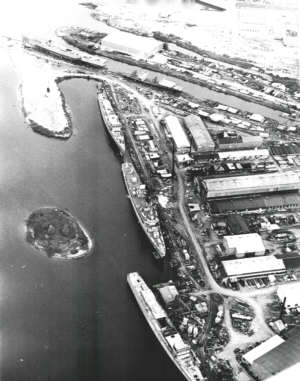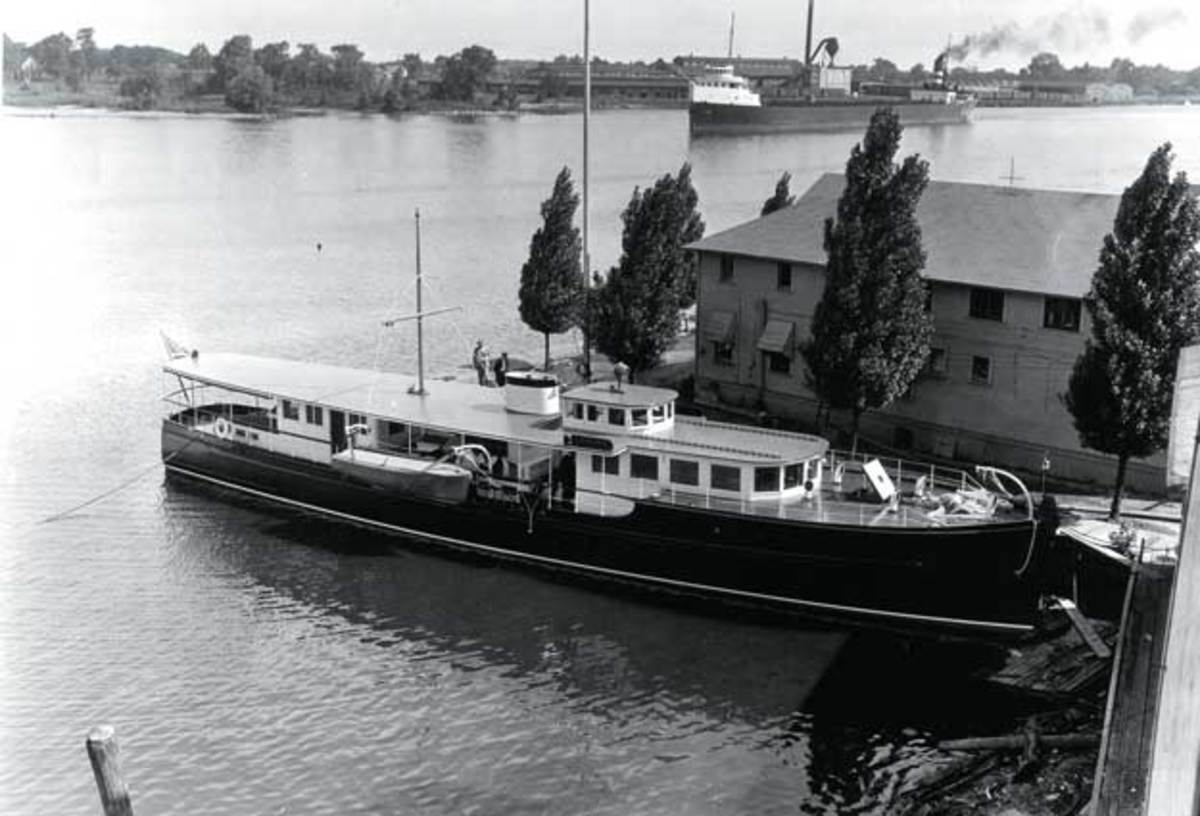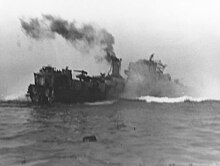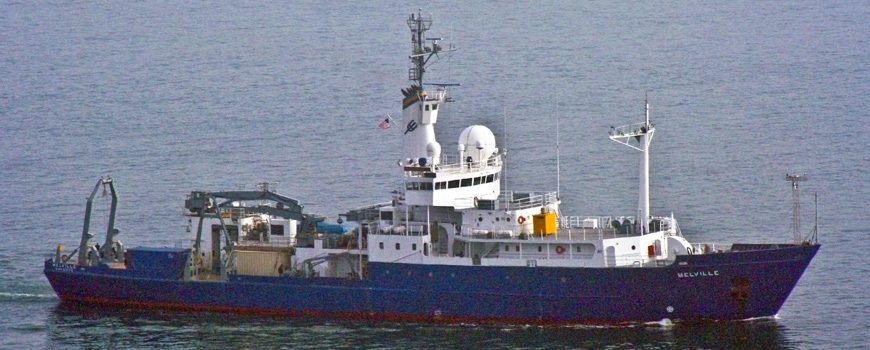
Started in 1905 as a small wooden boat building business co-founded by brothers H. J. Defoe and F. W. Defoe and G. H. Whitehouse, the Defoe Shipbuilding Company came to produce several warships and support craft for the US and Australian Navies during The Second World War, the Korean, and the Vietnam Wars. The construction and contracts for these large vessels transformed the small yacht building business into a sprawling naval powerhouse that dominated the Saginaw river. This allowed the shipyards to manufacture new patrol craft and destroyers every few weeks. Notable craft include the USS Escanaba, USS Rich, HMAS Brisbane, and the HMAS Pirth. In 1976 Defoe Shipbuilding Company closed its yard and sold to H.H Hirshfield & Sons scrap yard.
From Humble Beginnings
Founded in 1905, Defoe Shipbuilding Company opened a small boat shop in Bay City Michigan. The company was created as a partnership between brothers F.W. Defoe, H.J. Defoe, and G.H Whitehouse. At this time Whitehouse was a business owner in the Bay City fishing market, while H.J. Defoe was a principal of Bay City Schools and F.W Defoe was a lawyer[2,9]. The company was founded to create fishing boats to exploit the flourishing fishing industry of the Great Lakes at the time. This company ran under the name “Defoe Boat and Motor Works”. The first boats created were small fishing boats called “trap net skiffs”. These were flat/semi-flat bottom boats with two sails for propulsion. At the time, these types of fishing vessels were so numerous in the Saginaw Bay that a person could see three to four of these in the bay at any given time[6]. From 1905 onward, with the invention of the gasoline engine, ships completed included a gas engine, with older ships being replaced or converted to engine-based propulsion.
The gasoline engine also sparked a renewed interest in pleasure craft due to the reduced knowledge needed to sail leisurely on the Great Lakes. From 1911 to around 1917, the company began building pleasure and business gas powered yachts. During this time, around 20 powered yachts were completed as well as a few more fishing boats and a few smaller craft[2,6]. These yachts were sold around the world, from China to England, and two were sold to the Bay City government. The well-engineered yachts earned the business a nice reputation and gained the United States governments’ attention[6]. Thus, in late 1916 during the WWI buildup, the US Navy contracted the Defoe Boat and Motor Works to build five 40ft Spent-Class torpedo chasers to be delivered by early 1917[2]. At the time, this was the largest undertaking the company had ever accepted with US Navy scrutiny being much higher than what they were used to. Regardless, they impressed the Navy’s inspection crew and completed the job on time. Once the US joined the war in 1917, the Defoe’s obtained a military contract to build eight 100ft U.S Army Transport Service steam mineplanters[1]. This forced them to construct a steel mill and expand their site to across the river[1,2]. Many citizens of Bay City had prior shipbuilding and steel smithing “know-how” from working at The American Shipbuilding and F.W Wheeler Companies which by 1905 were shut down[5]. Supplied by the steel-knowledgeable workforce of Bay City, the steam mineplanter contract was completed in 1921. Some of these mineplanters were still in operation until 1964 as tugboats[6].
After the war came the prohibition era. During 1921 to 1925, Defoe built fifteen, 75ft wooden “rum-runner” chasers and twelve, 100ft steel vessels of the same class for the US Coast Guard. These were in high demand on the Great Lakes and many were rushed out of dock as soon as they were completed to aid in catching alcohol smugglers[2,6,9]. After building rum-runners, a long period of yacht construction ensued up until the early 1930’s when the great depression hit. To compete with larger yards such as Lawleys, Bath, Pusey and Jones, and Chas.Seabury, the company built up a joinery and finish department to improve the quality of their yachts[3]. In 1962, when a yacht built in 1930 made a journey back to Bay City, “the finish and woodwork looked as new as they day it was completed”[2]. At this time Defoe’s craftsmanship was so renown that future president John F. Kennedy’s personal yacht was a 1931 Defoe called the HONEY FITZ[6,9].
The Depression/WWII

The yacht building industry quickly ground to a halt as the Great Depression proliferated in the early 1930s. The company didn’t quite feel its effects though due to the US Coast Guards ordering of three steam turbine cutters in 1931. Named Onondaga, Tahoma, and Escanaba, these cutters were enough to keep the company afloat during the depression[6]. While all three ships provided Coast Guard services, The Escanaba was upgraded with two 3in guns and six AA machine guns and sent out to the Atlantic theater in 1942. Once there it saved 130 sailors from torpedoed merchant ships[12]. After delivering these three ships between 1932 and 1934, Defoe was then contracted to make two lighthouse tenders, Elm and Hollyhock, a fireboat, Fred A Busse, and a few more personal yachts[2]. By 1938, another US Coast Guard contract for two ice breakers, Naugatuck and Raritan, was accepted and completed by April of 1939[2,6]. These two 90ft ice breakers could run though 12in ice and were in service until 1980.
Soon after, the US government began ramping up wartime industries and became the sole contractor to Defoe until the war’s end. The first contract was to design two patrol craft (PC) boats (451,452), along with a second contract to construct the U.S. Navy’s first 173ft Subchaser. PC Boat 451 was delivered on time and in satisfactory condition, while PC Boat 452 was towed to the coast without engine. PC Boat 452’s design was nevertheless adopted for the remaining PC Boat fleet[2,6]. As soon as the ships left dock, construction of three, 100ft electric tugs and four, 220ft diesel electric minesweepers took place[2,6,9]. Around this time Defoe Boat and Motor Works changed their name to Defoe Shipbuilding Company. At PC Boat 452’s acceptance as the standard PC boat, Defoe began a side program of quantity production of PC boats until the end of the war. To help expedite the construction of the numerous boats, the Defoe Company invented a method to eliminate most of the overhead welding. Coined the “roll-over method”, large cranes would hold the hull upside down on a cradle which would then roll upright once the hull was completed[2,6,7,9]. By eliminating overhead welding, the company was able to turn out one 173ft PC boat per week. Using the same method, Defoe built twenty-eight, 309ft destroyer escorts, the first being delivered Aug 12th, 1943. Eleven of these were altered into troop carrying landing craft for use in delivering large quantities of troops and equipment to the makeshift Mulberry Harbors of Normandy, France . This destroyer escort program could turn out a ship in around 25 days and ran till the end of the war. Meanwhile, in 1941, Defoe constructed four 143ft electric tugs which were sent to the British Navy. Around March of 1944, Defoe began to also construct U.S. Navy Landing Craft with a turn out rate of around six per month until October the same year. The last wartime contract was for ten YF Lighters delivered by Oct 1945[2,6].
All ships manufactured during the war at Defoe Shipbuilding Company, with the exception of one, 220ft Minesweeper and the British Tugboats, had to be delivered to New Orleans via the Mississippi[2]. This was done to protect them from the German submarines (U-boats) operating in the St. Lawrence and the Atlantic seaboard. The boats sailed from Bay City to Chicago under their own power. There they were placed under tow and then taken down the Mississippi river. This process was difficult, especially for the large Destroyer Escorts which, at some points had to have their upperwork dismantled to fit under bridges and be assisted with pontoons to be able to make it through the canal that linked Chicago to the Mississippi[2]. Of the craft constructed, four were sunk during WWII; The USS Escanaba was struck by a torpedo during the Battle of the Atlantic in 1943 and sunk with all but two hands; USS Rich was struck by a mine off the shore of Normandy, sinking June 8th, 1944 while being shelled by German coastal artillery with a loss of 91 hands; USS PC-1129, the flagship for the control unit TU 78.2.7, was struck on January 31st,1945 by a Japanese suicide boat off the coast of Luzon in the South China Sea; PC-482 was given to the Free French Navy who renamed the ship L’Enjou (W44) and was struck by a German U-Boat while escorting a convoy off the Cape Spartel, Morocco.

After WWII
With the close of the war came the cancellation of remaining contracts. A contract for thirty 180ft minesweepers was scrapped and lay-offs and cutback on the workforce ensued. The company decided to return to yacht building and, after a series of advertisements, sold eight, 188ft seagoing yachts. All are still operating satisfactory according to their owners[2]. With a good reputation with the U.S. Coast Guard, Defoe again was contracted to construct two 120ft lightships; the Diamond and Pollack. After completion in 1946, Defoe began to do repair work. They upkept some of the PC boats that were used for training on the Great Lakes, as well as Mackinaw, Petoskey, Munising ferries, and Great Lakes freighters until in 1952-53 they built two, 643ft Great Lakes freighters; the Richard M. Marshall and the Charles L. Hutchinson[2]. This jumped them back into the shipbuilding business and they were contracted by the US Steel Corp. to build three diesel powered tugs. In 1954, they delivered one 57ft experimental all plastic minesweeper for the U.S. Navy which, although the idea was scrapped, restarted steady US Navy contract work[2,6]. Starting from 1954 onward they constructed two, 315ft destroyer escorts and four 440ft guided missile destroyers;the Courtney, the Lester, the Wilson, the McCormick, the Robinson, and the Hoel respectively. After completion of the Hoel in mid-1962, a contract to build three additional 440ft guided missile destroyers was granted[9]. Upon completion, they were given to the Royal Australian Naval Fleet and named HMAS Perth, HMAS Hobart, and HMAS Brisbane[10]. These three Australian ships saw action in the coming Vietnam war. While constructing the 440ft destroyers, Defoe simultaneously built three, 390ft frigates for the US Navy; the O’Callahan, the Koelsch, and the Voge[6]. The O’Callahan and the Koelsch would be leased to Pakistan in 1989 but recalled when Pakistan refused to discontinue their nuclear program.
The Final Years

Breaking the streak of warship construction was a contract to build two US Navy ocean research vessels in 1969. The Research Vessels (R/V) Melville and Knorr were used by the Office of Naval Research to conduct a wide range of scientific activities around the globe. The vessels sailed more than 1.5 million miles, crossed the equator over 90 times, were used to map the deepest spots in the ocean, and made the first ever observation of deep sea volcanic eruptions[11]. Many disciplines of oceanography benefited directly from data collected by these two vessels. Both retired recently in 2014 and 2016 respectively, serving nearly 45 years of constant use. In 1970, with the Vietnam conflict continuing to escalate, Defoe was once again contracted to build landing craft for the U.S. Navy. Construction of twenty-two, 200ft landing craft commenced late 1970 and averaged around one craft per two weeks until Oct 1971. After completion, Defoe was contracted to build three Great Lakes barges by Gulf Great Lakes Corp, Straits Transit Inc, and Hannah Marine. The last, completed on March 1976, was the last ship to be built at the Defoe Shipyards. All three freighters are still currently trading on the Great Lakes. Without Navy work from 1971 onward and other contracts going to competing shipyards, on December 1976, Defoe closed its yard and sold its location to H.H. Hirshfield and Sons Scrap Yard which was recently bought by another scrap company OmniSourc, Inc[6,8]. During its time, of operation Defoe’s steel yard contributed to other major works in addition to shipbuilding. This includes the base of the first steam catapult to be built for the U.S. Navy for their carriers and the pipe and caissons that were built for the 26,000ft Mackinac Bridge[6,8]. Many other commercial structures in the Midwest can trace steel back to the Defoe Steel Mill, owing to the efficacy with which Defoe’s legacy was built upon.
Primary Sources
- Carter, Frank E. “Defoe Boat and Motor Works.” Michigan Manufacturer & Financial Record, vol. 22, 12 July 1918, p. 38
- Swanson, F. A. Society of Naval Architects Marine Engineers, 21 May 1964, Bay City, MI. Address
- Prial, Francis P. “The DeFoe Boat and Motor Works” The Motor Boat: Devoted to All Types of Power Craft, vol. 7, 1910, p. 52-53
- Gluntz, Marvin H. “Naval Construction on the Great Lakes” Proceedings Magazine, vol 82, issue 2, p. 643, Feb 1957
- Strole, D. L., Dutcher, W. E., “Naval and Maritime Events, 1 July 1968-31 December 1969” Proceedings Magazine, vol 96, issue 5, page 807, May 1970
Secondary Sources
- Defoe, David. “The Defoe Story.” 18 April 2014
- Joachim, George J. “1942-1945: Quotas and Controversy” Iron Fleet: The Great Lakes in World War II, vol 1, Wayne State University Press, Detroit, 1996
- Egan, Leigh. “Defoe Shipbuilding Company” 2017
- Kusmierz, Marvin. “Defoe Boat and Motor Works (1905-1972)” Bay-Journal, April 2003
- Baker, A. D. “Combat Fleets” Proceedings Magazine, vol 120, issue 4, page 1095, May 1994
- Scripps Institution of Oceanography. “Retirement Ceremony Announcement” Feb 2015
- Browning, Jr., Dr. Robert M., “The Sinking of the USCGC Escanaba”, U.S. Coast Guard Historian’s Office
For Further Reading
- A video history of the Defoe Shipbuilding Company
- A published list of ships completed at the Defoe Shipyards
